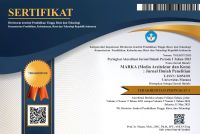Pengembangan Kawasan Berkarakter Urban Crack melalui Desain Pasar Tematik Berbasis Material Daur Ulang Kain di Ciakar, Tangerang
Abstract
Ciakar Village, located in Panongan sub-district, Tangerang Regency, Banten, experienced significant physical spatial development, namely land use change from agriculture to settlements. The phenomenon of urban crack emerged as a result of this development. Urban crack refers to a narrow area hidden behind a prosperous and once thriving area that no longer has energy and is intrinsically characterized by emptiness. Urban crack in Ciakar village is triggered by the gated community system in the housing clusters that flank the site, resulting in street space that tends to be unmanaged and neglected which is then utilized wildly for plantations, kiosks, garbage disposal areas because there is no control and supervision.
The Ciakar village government plans to activate and revitalize this area by injecting a thematic market function that is expected to improve the quality of urban space as well as become an economic space for informal communities in improving their standard of living. The concept of a thematic market that combines culinary areas, shopping tours, educational tours, community activities by promoting local wisdom in the form of a park that can be built at an affordable cost. PKM UPH team contributed to propose the design of this thematic market. In the design process, there are two scales of design. Micro-scale design produces affordable building materials by utilizing fabric-based recycled materials with experimental methods to produce prototypes. The macro-scale design produces architectural design ideas for the thematic market by considering the existing context. In this study, the team used qualitative research methods. Data were collected from activities: field observations and Forum Group Discussions (FGDs) involving Ciakar Village government officials and community members. The design method used was a participatory design approach.
Downloads
References
Ardella, V. (2023). Fast Fashion dan Implementasi SDGS 12.6. 1 di Indonesia: Kewajiban Laporan Keberlanjutan Perusahaan. Moda: The Fashion Journal, 5(2).
Gahse, Z. (1997). A Small Essay at Cities Another & Another & Another Act of Seeing (Urban Space), eds. Moritz Küng and Katrien Vandermarliere, 204 (Antwerp: deSingel.
Khamdevi, M. (2018). Studi Potensi Lokal Kampung Cilegong Desa Mekarwangi dengan Analisis Spirit of Place. MARKA (Media Arsitektur dan Kota): Jurnal Ilmiah Penelitian, 2(1), 27-31.
Li, J., Ren, L., Hu, T., & Wang, F. (2018). A city's “urban crack” at 4 am: A case study of morning market vendors in Beijing's Longfu Temple area. Habitat International, 71, 14-21.
Muazimah, A., & Rani, F. (2020). Pengaruh fast fashion terhadap budaya konsumerisme dan kerusakan lingkungan di Indonesia. Jurnal Online Mahasiswa (JOM) Bidang Ilmu Sosial dan Ilmu Politik, 7(2), 1-15.
Sanders, E. B. N. (2002). Design and the Social Sciences: Making Connections Edited by Jorge Frascara. Print ISBN, 978-0.
Steel, R., Van Eeghem, E., Verschelden, G., & Carlos, D. (2012). Reading urban cracks: practices of artists and community workers. University College Ghent: School of Arts & Faculty of Education, Health and Social Work, and MER. Paper Kunsthalle.
Van Eeghem, E. (2013). Urban cracks: sites of meaning for critical artistic practices. Critical Arts, 27(5), 587-594.
Van Eeghem, E., Steel, R., Verschelden, G., & Dekeyrel, C. (2011). Urban Cracks: Interstitial spaces in the city. In The 17th International Symposium on Electronic Art, Istanbul, Turkey. Erişim (Vol. 14).
Verschelden, G., Van Eeghem, E., Steel, R., De Visscher, S., & Dekeyrel, C. (2012). Positioning community art practices in urban cracks. International Journal of Lifelong Education, 31(3), 277-291.
- Abstract 65
- PDF (BAHASA INDONESIA) 40
Copyright (c) 2024 Emanuel Agung Wicaksono, Fernisia Richtia Winnerdy, Angeline Sie Prayangga

This work is licensed under a Creative Commons Attribution-ShareAlike 4.0 International License.







